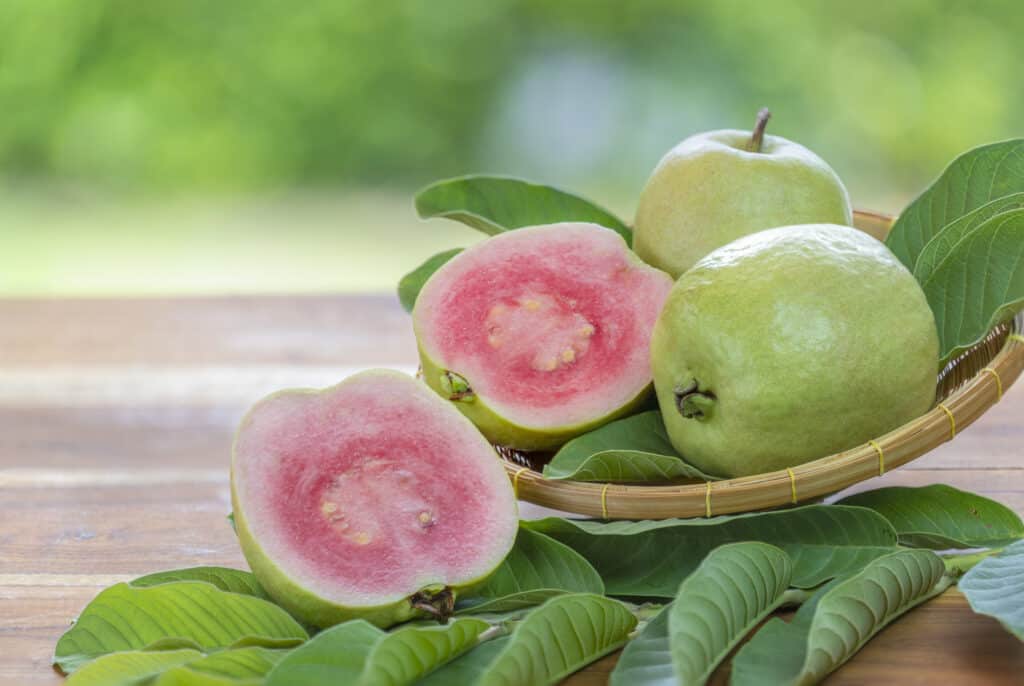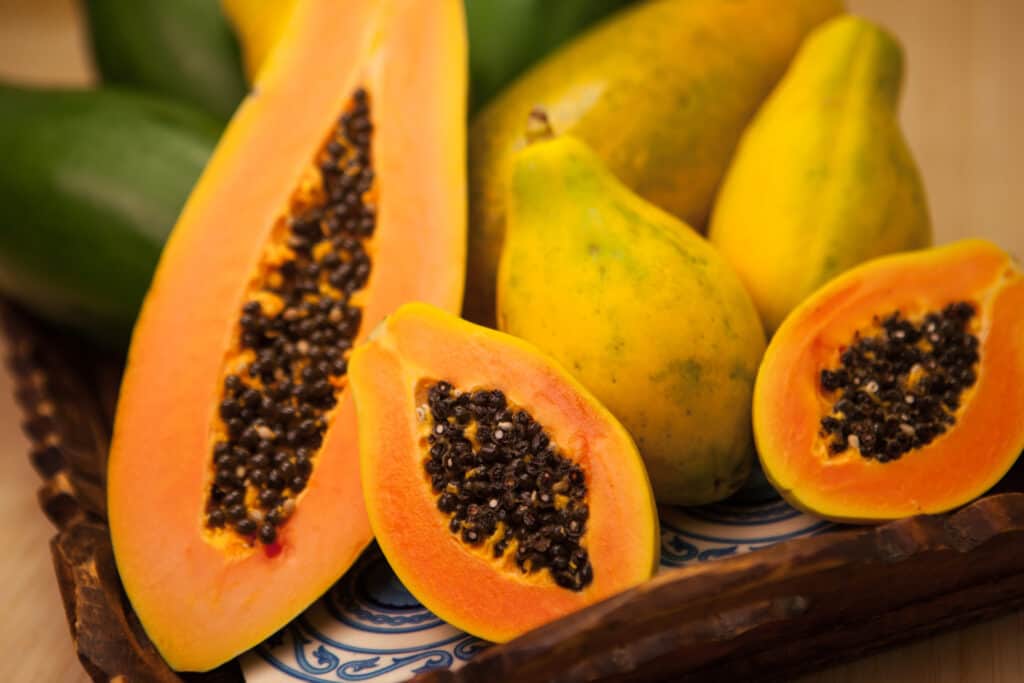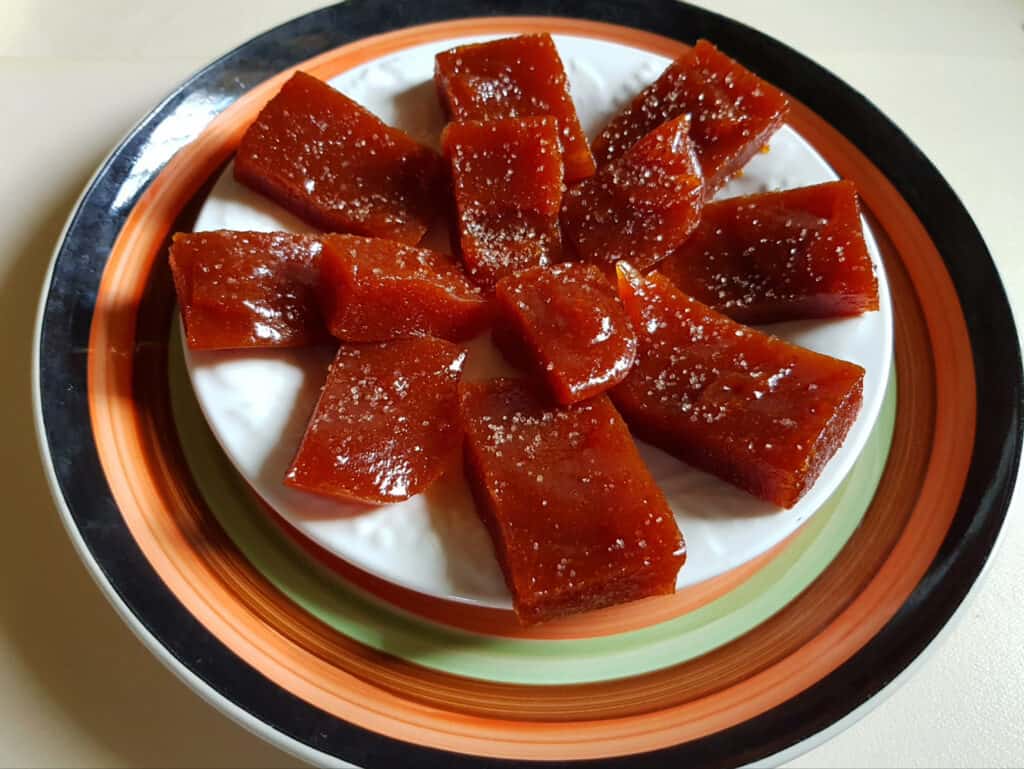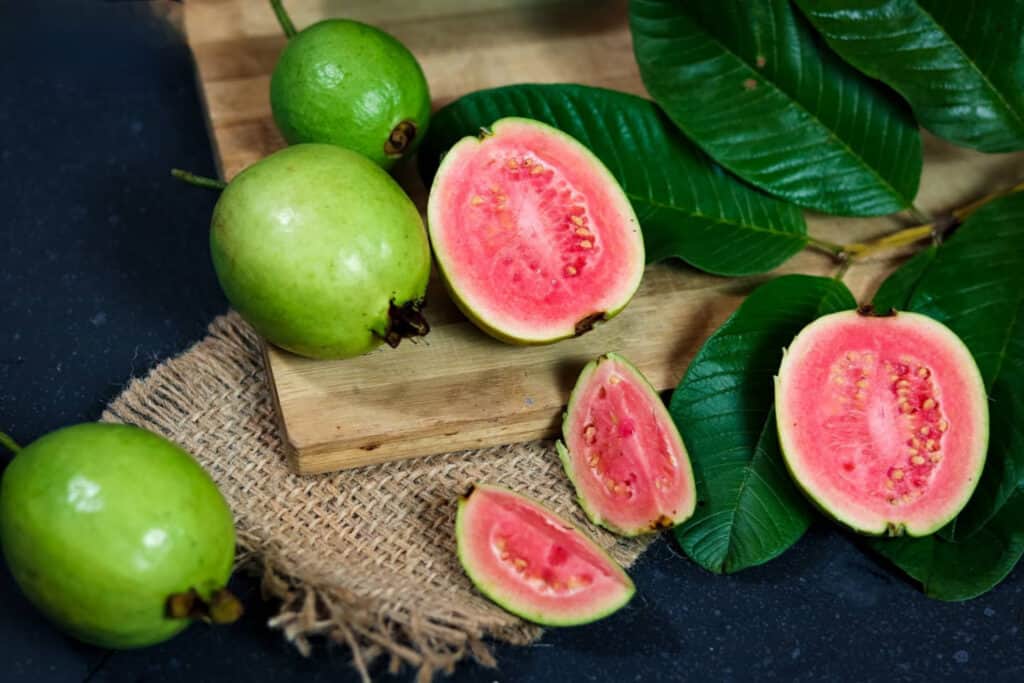Ripe guava and papaya are sweet, juicy, tropical fruits beloved across the world and enjoyed raw, cooked, and in numerous candies and other confections. Because of this, the two are often confused with each other. Here are some similarities:
- Both guava and papaya are edible fruits that grow on trees in tropical and subtropical regions of the world.
- Both guava and papaya are described as sweet and juicy.
- Both are popular flavors for candy, beverages, and sweets throughout Africa, Asia, and Central and South America.
However, there are other differences between guava and papaya that set them apart from each other and make them suitable for different uses. Let’s dive in and learn more about guava and papaya and where they come from as well as their history, appearance, taste, and uses.
Comparing Guava and Papaya
| Characteristic | Guava | Papaya |
|---|---|---|
| Scientific Name | Psidium guajava | Carica papaya |
| Common Name | Common guava | Papaya (pawpaw) |
| Origin | Caribbean, Central America, and South America | Caribbean and Central America |
| Description of Plant | Evergreen shrub or small tree, grown for its edible fruit. The trees can grow up to 33 feet tall and have smooth bark that can be green or red-brown, with branches that hang close to the ground. | Tree-like plant without branches, spirally-arranged leaves clustered together. Male papaya trees have flowers on long panicles. Female trees have single flowers or flower clusters that are yellow or green. The trees grow from 6 to 33 feet tall. |
| Description of Fruit | Round or pear-shaped with yellow skin and white, yellow, or pink flesh. The pulp includes small, hard, yellow-colored seeds. | Large with green skin that becomes yellow, with yellow, orange, or red-colored flesh and numerous black seeds. |
| Taste | Sweet, floral, musky | Sweet, juicy, and creamy |
| Uses | Guava may be eaten raw, frozen, or cooked. The guava flavor is popularly used in candy, with processed fruit byproducts fed to livestock and leaves used as fodder for animals. Guava leaves are high in quercetin, an active antioxidant, and guava fruit is considered a “superfood” by some, particularly because the fruit has high levels of vitamin C, potassium, and other beneficial nutrients. Guava is a staple of traditional medicine in cultures throughout the world to treat a range of medical conditions. | Papaya fruit are eaten fresh, dried, made into candy, or frozen. The young fruits and leaves can also be eaten. Papaya leaves and fruit have also long been used in traditional medicine. Today, papaya is known for its nutritional qualities, as a fruit high in antioxidants. It has a high level of vitamin A, vitamin C, and vitamin E. |
Guava vs. Papaya: Description
Guava, or Psidium guajava, is a member of the Psidium genus of the Myrtaceae family. Myrtaceae also includes many other commonly cultivated plants, including eucalyptus, nutmeg, and cinnamon. As one of the most popular and commonly-grown, Psidium guajava, known just as “guava,” “common guava,” or “apple guava,” is grown across the world in tropical and warmer sub-tropical climates. The guava plant is a shrub or small tree that can grow to be more than 30 feet tall in the right conditions. It bears white flowers and small, round, sweet, juicy fruit.
Guava fruit is popular both as a raw or cooked food and as a distilled flavor for candy and other confections. However, the fruit does possess a strong flavor. Because of this, while it is served as part of dessert or salad courses, it is often cooked and or made into juice or punch to distill its sweet flavor while reducing some of its pungency. This has made guava a staple ingredient in numerous jellies, candies, and other sweet recipes. Ripe guava bruises easily, so care must be taken during harvesting.

Guava fruit is round or pear-shaped with yellow skin and white, yellow, or pink flesh and yellow-colored seeds.
©iStock.com/ruksutakarn
Papaya, or Carica papaya, is a member of the Carica genus of the Caricaceae family. Caricaceae also includes five other genera, which contain approximately 34 other species, some of which have edible fruit. Carica papaya, also known as “papaya,” “papaw,” or “pawpaw,” is one of 22 other species in the Carica genus. Like guava, it is also grown across the world and cultivated in many tropical countries.
Papaya plants can grow in male, female, and hermaphrodite variations, with the vast majority of cultivated papaya trees being hermaphrodite trees that can self-pollinate. The male papaya trees produce pollen but not fruit. Female papaya trees produce fruits that are only edible when pollinated. The hermaphrodite variation produces both flowers that have male stamens and female ovaries. As a result, it can self-pollinate. This has led hermaphrodite papaya trees to be most prevalent among commercial growers. The fruit produced by these papaya plants has smooth, green skin and thick, succulent flesh. It is also often eaten raw, cooked, or as a flavor in candies and other products.

Papaya fruit are large with green skin that becomes yellow, with yellow, orange, or red-colored flesh and numerous black seeds.
©iStock.com/PixoStudio
Guava vs. Papaya: Native Region and Climate
Guava is native to Central and South America and grows well in tropical and warm-subtropical climates, such as those found in Mexico and Chile. In the United States, guava is grown in parts of California, Florida, and Texas, as well as island climates like Hawaii. Today, guava is often found in temperate regions of Asia, Australia, and its native home of Central America. While it may be cultivated outside of its native geography, guava will thrive best in climates similar to the warm, humid environment of Central America, and it must be protected from drops in temperature that will kill the guava plants.
Papaya is native to the Central American region and can grow in tropical and warm sub-tropical climates around the world. It is native to countries such as Mexico and Costa Rica, but a large amount of the world’s papayas are cultivated in countries like India. Today, papaya can also be grown in warmer parts of the United States, such as Texas and Florida. Like guava plants, because papaya thrives in humid climates, it will not grow well in places with cold temperatures. Particularly in climates with temperatures that drop below freezing, the colder weather will kill smaller papaya plants or harm the growth of larger ones.
Guava vs. Papaya: History and Production
From its original home in Mexico and other countries in Central and South America, guava spread across the world and became a tropical favorite and staple cuisine. When Portuguese colonizers came to Central and South America, they began exporting guava all over the globe, bringing guava to countries like China, India, South Africa, Pakistan, the Philippines, and Thailand. These countries have since become major producers of guava and the fruit can be found as an ingredient in drinks, sauces, and candy, and as a snack on its own.
Papaya, on the other hand, traveled throughout Central America from Mexico in the centuries prior to European colonization. When Spanish colonizers came to Central America in the 16th century, Spanish sailors began exporting papaya and eventually introduced it via trade to parts of Asia, beginning with the Philippines. Today, countries like Brazil, Dominican Republic, India, Indonesia, and Nigeria lead the world in papaya production. Farmers in and many countries throughout Asia and Africa grow papaya as a commercial crop.

Guava is often an ingredient in drinks, sauces, candy, and prepared as a dessert or snack.
©iStock.com/Cora Tesheira
Guava vs. Papaya: Appearance
Some of the biggest differences between guava and papaya are found in their appearance: length, weight, fruit color, and seeds.
Guava fruit come from the Psidium guajava tree (also called “lemon guava” or “apple guava”), which grows up to 30-33 feet tall. The name “guava” also applies to some other species in the Psidium genus, which contains 150 other species, including “strawberry guava” (Psidium cattleyanum) and “pineapple guava” (Psidium sellowiana). However, Psidium guajava is cultivated commercially and gained the most wide-spread appeal. The guava tree, or shrub, has short trunks with branches that grow from the base and are flexible, with oval or oblong-shaped leaves that grow in opposite pairs and measure 2 to 6 inches long. The leaves are typically smooth, with prominent veins on the bottom. While flowers grow individually or in groups of two to three, each with four or five petals.
Papaya fruit, also called “papaw” or “pawpaw,” come from the Carica papaya tree, which also grows up to 30-33 feet tall. Carica papaya is one species in the Carica genus, which contains 22 other species in the Caricaceae family. The papaya tree is small with few branches and typically grows as a stem up to 33 feet tall, with leaves that grow in a spiral at the top of the trunk. You might also see marks on the lower trunk area, reflecting past growth of leaves and fruit. Each leaf is about 20-28 inches across, with seven lobes and white or yellow flowers that grow in trumpet-shaped blossoms that are 1 to 2 inches long.

The papaya tree grows as a stem up to 33 feet tall, with few branches and leaves that grow in a spiral at the top of the trunk.
©iStock.com/Elisa Irmalia
Guava vs. Papaya: Fruit
Papaya fruit can grow to be between 3 and 20 inches long, sometimes weighing as much as 20 or 25 pounds. Unripe papayas are bright green and have pale, yellowish flesh and numerous white seeds. As it ripens, papaya fruit flesh turns deep yellow, orange, or pink and the white seeds turn black. But don’t wait too long! Overly-ripe papaya become mushy and bland.
Guava fruit grows to be about 2 to 3 inches in diameter and about 1.7 to 2 ounces. As they ripen, the fruit turns from dark green to yellow, sometimes with a pink hue. Inside, the guava flesh can range from white to yellow or pink, with pale, round yellow seeds.
Guava vs. Papaya: Taste
Guava tastes sweet and flowery, with some describing the pungent flavor as “musky”, and somewhere between the flavor of a strawberry and that of a pear. Unripe guava fruit can taste sour and the texture is harder, similar to that of an unripened pear. However, after they ripen, guava is soft and juicy, with sweet flavor that is less acidic and gives off a strong, sweet scent. Some people do compare the taste of guava to that of a ripe papaya.
Papaya is sweet and creamy, with some describing the texture as “buttery.” When ripe, papaya is juicy and soft, with some describing the texture of papaya as a hybrid of pumpkin and cantaloupe, with the fruit a little bit softer than that of a melon. Unripe, or green, papaya will be sour and should not be eaten uncooked, as the unripened fruit contains an enzyme called papaya latex, which can damage one’s esophagus and cause symptoms like nausea and vomiting.

Guava fruit is considered a “superfood” because the fruit has high levels of vitamin C, potassium, and other beneficial nutrients.
©iStock.com/Abdul Sameer
Guava vs. Papaya: Uses
Both guava and papaya are popular flavors for candy, jellies, and other confections, particularly in Asia and parts of Central and South America.
Guava exports are mostly as fresh fruits, as pastes or purees, and as preserves. Other popular guava products include cosmetics, drinks, and baked goods. Additionally, key exporters of guava are Thailand, Mexico, Peru, and Brazil. Guava has many nutrients that make the fruit a great addition to a healthy diet. In addition to eating the fruit, boiling the leaves in hot water to brew an herbal tea can be a dietary supplement. The leaves may also be made into an extract to improve digestion or reduce the severity of menstrual cramps.
You will also find parts of papaya plants showing up as key ingredients in brewing, pharmaceuticals, beauty products, and cosmetics across the world. Papayas are grown in more than 60 different countries with key exporters being Mexico, Brazil, and Belize. Because papaya has recently garnered acclaim as a “superfood,” many people have begun consuming papaya for benefits such as reducing the risk of heart disease, diabetes, and cancer. There is also evidence that eating papaya can aid in digestion, lowering blood pressure, and wound healing.
Papaya also produces an enzyme called papain, a proteolytic enzyme that breaks proteins into smaller proteins. These fragments are called peptides and amino acids. Because of this unique quality, papain from papayas can be used to make meat tenderizers and has been made into supplements to be taken in small doses. Some health experts suggest that papain can have multiple health benefits and be used to relieve pain or heal certain wounds.

Papaya fruit can grow up to 20 inches long and weigh as much as 20 or 25 pounds.
©iStock.com/nattaphol phromdecha
Growing Guava and Papaya
Since both guava and papaya originate in tropical and warm sub-tropical climates, they can be grown in parts of the world that are hot, humid, do not have extreme drops in temperature, and which are not windy. In the United States, this can include parts of California, Florida, and Texas.
If you would like to grow your own guava tree, remember that the guava plant will grow best between 73° and 82°F. Cold weather will kill your guava tree. Therefore, while short periods of colder temperatures may not hurt your plant significantly, longer-term periods of cold will hurt the stems and trunk of your guava tree. Guava plants are also relatively resilient in the face of wet soil. However, long periods of soil saturation or flooding can kill the tree or lead it to drop fruit and leaves. The plants are also relatively tolerant of windy weather and drought.
If you are interested in growing a papaya plant, know that they thrive best in places where the temperature stays between 70° and 90°F. The soil should stay above 60°F. Avoid windy areas, which can harm the plant’s growth. It is also important that papaya plants receive adequate rainfall. When grown in sub-optimal conditions, your papaya plant will have reduced flowers and fruits. Keep these parameters in mind so that your papaya plant can grow to reach its maximum potential.
In Summary
This article compares guava and papaya, two delicious fruits with numerous health benefits. If you live in a warm and humid climate, consider growing a guava or papaya tree yourself. If not, you can enjoy the two fruits by eating them raw, cooking or drying them, or purchasing a guava- or papaya-flavored candies.
Next Up
The photo featured at the top of this post is © iStock.com/Murilo Gualda
Sources
- University of Florida, AN OVERVIEW OF GLOBAL PAPAYA PRODUCTION, TRADE, AND CONSUMPTION, Evans and Ballen, Available here: https://edis.ifas.ufl.edu/publication/FE913#:~:text=In%20addition%2C%20papaya%20is%20a,production%20occurring%20in%20developing%20economies.
- University of Florida, GUAVA GROWING IN THE FLORIDA HOME LANDSCAPE, , Available here: https://edis.ifas.ufl.edu/publication/MG045
- World Integrated Trade Solutions, Available here: https://wits.worldbank.org/trade/comtrade/en/country/ALL/year/2019/tradeflow/Exports/partner/WLD/product/080450
- University of Florida, PAPAYA GROWING IN THE FLORIDA HOME LANDSCAPE, Crane, Available here: https://edis.ifas.ufl.edu/publication/MG054
- Encyclopedia Brittanica, Available here: https://www.britannica.com/plant/common-guava
- USDA, Available here: https://dpi.wi.gov/sites/default/files/imce/school-nutrition/pdf/fact-sheet-guava.pdf
- Julia Ostmann , Available here: https://daily.jstor.org/plant-of-the-month-guava/
- Encyclopedia Brittanica, Available here: https://www.britannica.com/plant/papaya
- USDA, Available here: https://dpi.wi.gov/sites/default/files/imce/school-nutrition/pdf/fact-sheet-papaya.pdf
- Web MD, Available here: https://www.webmd.com/vitamins/ai/ingredientmono-488/papaya
- Web MD, Available here: https://www.webmd.com/diet/health-benefits-guava
- World Crop Pests, Available here: https://www.sciencedirect.com/topics/pharmacology-toxicology-and-pharmaceutical-science/psidium#:~:text=The%20genus%20Psidium%20consists%20of,importance%20and%20outgrow%20the%20others.
Thank you for reading! Have some feedback for us? Contact the AZ Animals editorial team.






